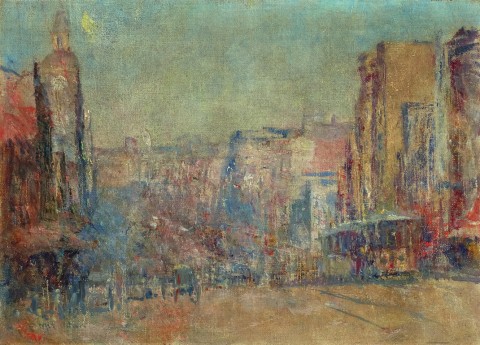COLLINS STREET, MELBOURNE, c.1915
FREDERICK McCUBBIN
oil on canvas board
25.5 x 35.5 cm
signed lower left: F McCubbin
Sir Keith Murdoch, Cruden Farm, Victoria
Thence by descent
Dame Elisabeth Murdoch, Cruden Farm, Victoria
Thence by descent
Private collection, Melbourne
Collins Street, c.1915, oil on canvas board, 25.5 x 35.5 cm, in the collection of Geelong Gallery, Victoria
Collins Street, c.1915, oil on canvas board, 25.5 x 30.5 cm, in the collection of National Gallery of Victoria, Melbourne
In 2009, the National Gallery of Australia exhibition, McCubbin: Last Impressions 1907–17, showcased the work produced by Frederick McCubbin during the final eleven years of his life. Curated by Anne Gray, the exhibition featured three Collins Street sketches all painted around 1915 on 10 x 12-inch canvas board. Notably, this group of smaller Melbourne cityscapes – which included the nearby Flinders Street subjects – were the most abstract in the exhibition.
The following excerpts are from Anne Gray’s catalogue essays and notes accompanying the group of Collins Street, c.1915 works:
‘…In 1915, at the age of 60, McCubbin purchased an old Renault, and became, according to Daniel Thomas, ‘a modern motorised McCubbin’. The car was used for painting excursions into the city, and McCubbin began a new series of works of this most modern of subjects. He delighted in capturing the flickering light, and the almost dissolving, abstract forms of the city’s activity.
As his daughter Kathleen recalled, ‘We parked near the top end of Collins Street, facing the city. The latish afternoon sun was shining brilliantly on the tops of the buildings, and this was the ideal subject for one of father’s swift sketches. Hastily taking out his palette from the box he always carried in the car, he squeezed out blobs of paint and swiftly blended the colours together with his palette knife. Within moments the sky and the illuminated facades began to take shape on the sketching board (Mangan, 1984, p 50).’1
‘Long regarded as one of Melbourne’s most fashionable and cosmopolitan streets – the address of some of the city’s most exclusive retailers and clubs, as well as medical, financial and cultural institutions – Collins Street was the subject of a number of paintings from McCubbin’s later years, continuing his longstanding interest in urban vistas.
As one of the principal east-west thoroughfares in Robert Hoddle’s original city grid of 1837, Collins Street was at the peak of its splendour on the mid 1880s when McCubbin took up his appointment as drawing master at the National Gallery’s school. Throughout his career, he maintained an association with a number of premises and organisations located on the street (or within adjoining arcades), including Grosvenor Chambers, Athenaeum Hall, the Savage Club and the offices of the Australasian Sketcher.’2
Commenting on McCubbin’s painting technique for Collins Street, c. 1915 (National Gallery of Victoria) Anne Gray noted: ‘…the surface of the work is encrusted with small, jewel like dabs of paint. Other areas are painted thinly or rubbed back. McCubbin has also scraped into the paint with the handle of the brush to create highlights. The scene is highly abstracted, the people on the street mere vertical notations of paint, the facades of the buildings appearing to dissolve into pure colour and pattern, recalling Monet’s series of paintings of the façade of Rouen cathedral.‘3
1. Gray, A., McCubbin: Last Impressions 1907-17, National Gallery of Australia, Canberra, 2009, p. 145
2. Ibid., p.147
3. Ibid., p.145
